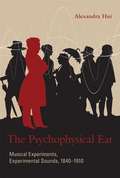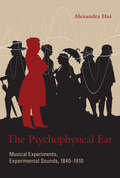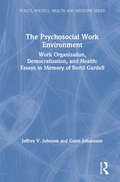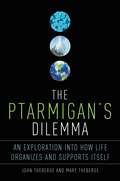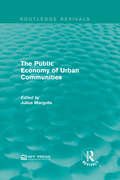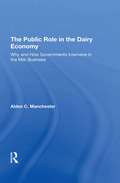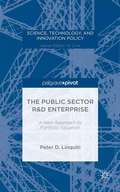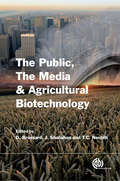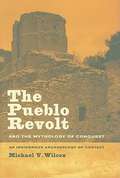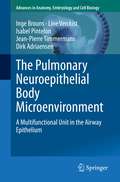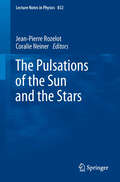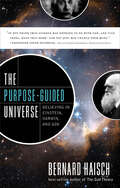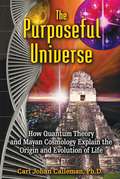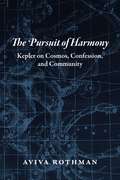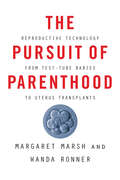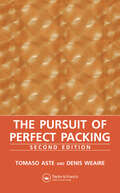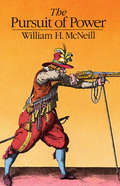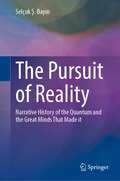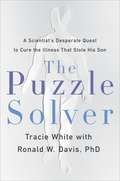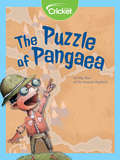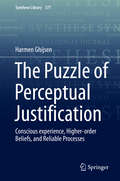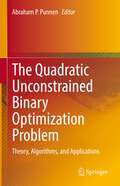- Table View
- List View
The Psychophysical Ear
by Alexandra HuiIn the middle of the nineteenth century, German and Austrian concertgoers began to hear new rhythms and harmonies as non-Western musical ensembles began to make their way to European cities and classical music introduced new compositional trends. At the same time, leading physicists, physiologists, and psychologists were preoccupied with understanding the sensory perception of sound from a psychophysical perspective, seeking a direct and measurable relationship between physical stimulation and physical sensation. These scientists incorporated specific sounds into their experiments--the musical sounds listened to by upper middle class, liberal Germans and Austrians. In The Psychophysical Ear, Alexandra Hui examines this formative historical moment, when the worlds of natural science and music coalesced around the psychophysics of sound sensation, and new musical aesthetics were interwoven with new conceptions of sound and hearing. Hui, a historian and a classically trained musician, describes the network of scientists, musicians, music critics, musicologists, and composers involved in this redefinition of listening. She identifies a source of tension for the psychophysicists: the seeming irreconcilability between the idealist, universalizing goals of their science and the increasingly undeniable historical and cultural contingency of musical aesthetics. The convergence of the respective projects of the psychophysical study of sound sensation and the aesthetics of music was, however, fleeting. By the beginning of the twentieth century, with the professionalization of such fields as experimental psychology and ethnomusicology and the proliferation of new and different kinds of music, the aesthetic dimension of psychophysics began to disappear.
The Psychophysical Ear: Musical Experiments, Experimental Sounds, 1840-1910 (Transformations: Studies in the History of Science and Technology)
by Alexandra HuiAn examination of how the scientific study of sound sensation became increasingly intertwined with musical aesthetics in nineteenth-century Germany and Austria.In the middle of the nineteenth century, German and Austrian concertgoers began to hear new rhythms and harmonies as non-Western musical ensembles began to make their way to European cities and classical music introduced new compositional trends. At the same time, leading physicists, physiologists, and psychologists were preoccupied with understanding the sensory perception of sound from a psychophysical perspective, seeking a direct and measurable relationship between physical stimulation and physical sensation. These scientists incorporated specific sounds into their experiments—the musical sounds listened to by upper middle class, liberal Germans and Austrians. In The Psychophysical Ear, Alexandra Hui examines this formative historical moment, when the worlds of natural science and music coalesced around the psychophysics of sound sensation, and new musical aesthetics were interwoven with new conceptions of sound and hearing.Hui, a historian and a classically trained musician, describes the network of scientists, musicians, music critics, musicologists, and composers involved in this redefinition of listening. She identifies a source of tension for the psychophysicists: the seeming irreconcilability between the idealist, universalizing goals of their science and the increasingly undeniable historical and cultural contingency of musical aesthetics. The convergence of the respective projects of the psychophysical study of sound sensation and the aesthetics of music was, however, fleeting. By the beginning of the twentieth century, with the professionalization of such fields as experimental psychology and ethnomusicology and the proliferation of new and different kinds of music, the aesthetic dimension of psychophysics began to disappear.
The Psychosocial Work Environment: Work Organization, Democratization, and Health : Essays in Memory of Bertil Gardell (Policy, Politics, Health and Medicine Series)
by Jeffrey V. Johnson Bertil Gardell Gunn JohannsonDedicated to the late Bertil Gardell, a Swedish Social Scientist, this text comprises of 18 essays that shares a common vision - the impact of work on the interconnected processes of stress and disease.
The Ptarmigan's Dilemma: An Ecological Exploration into the Mysteries of Life
by Mary Theberge John ThebergeDrawing on breakthrough research in evolution, genetics, and on their extensive work in the field and lab, wildlife biologists John and Mary Theberge explain for non-scientists the real facts of life. Birds that suddenly grow gall bladders, when their species has none. Moose with antlers so big they encumber their movement through the forest. Butterflies that risk extinction by overwintering en masse. These are just a few stories the Theberges tell in their examination of what the mechanisms of evolution are and how they work. With examples from the very latest discoveries in genetics and ones they have made in their own field work, The Ptarmigan's Dilemma is a ground-breaking explanation of evolution for non-scientists. By marrying the separate sciences of ecology and genetics, the Theberges paint a picture far richer than either discipline can alone of how, for almost 4 billion years, life on Earth has evolved into the rich diversity that's under threat today. Along the way, they explain just what "the survival of the fittest" really means, how dramatic evolutionary changes can take place in just one generation, and how our too-little knowledge of or interest in how life on Earth organizes and supports itself is rapidly making us a danger to ourselves.
The Public Economy of Urban Communities: Papers Presented At The 2nd Conference On Urban Public Expenditures, Feb. 21-22, 1964 (Routledge Revivals)
by Julius MargolisOriginally published in 1965, Margolis brings together a wide variety of papers on a multitude of subjects relating to the urban public economy presented at the second conference on urban public expenditures in 1964. This collection covers issues such as criteria for decision-making in urban public spending, public and private supply and the political and voting behaviour of urban economies in order to contribute to the development of new analytical models and techniques as well as to disseminate findings of research results to a larger audience. This title will be of interest to those studying Environmental studies and Economics as well as professionals.
The Public Role In The Dairy Economy: Why And How Governments Intervene In The Milk Business
by Alden C ManchesterAll over the world, governments play a part in the milk business for compelling economic reasons and not, as many assert, just because dairy farmers are numerous and organized. This book examines the role of federal, state, and local governments in the dairy economy of the United States, where major public involvement in industry began during the Great Depression. Dr. Manchester considers the conditions in the 1930s that led to government involvement, the changes that have occurred in the industry and the public role since then, and the prospects for the 1980s and beyond. He also analyzes possible alternative public dairy policies for the present and the rest of the decade. Many things have changed, points out Dr. Manchester, but the fundamental conditions that led to public involvement in the dairy industry still exist.
The Public Sector R&D Enterprise: A New Approach to Portfolio Valuation
by Peter D. LinquitiThe Public Sector R&D Enterprise combines a primer on how government R&D programs actually work with a sophisticated methodology for prospectively putting a dollar figure on the value of R&D investments before they are made.
The Public, the Media and Agricultural Biotechnology
by Dominique Brossard James Shanahan T. Clint NesbittThis book reviews the literature on communication about biotechnology. However this book with the use of case studies looks at public opinion data, communication theory, and international examples; to provide a complementary overview of how the public sees this controversial topic.
The Pueblo Revolt and the Mythology of Conquest: An Indigenous Archaeology of Contact
by Michael V. WilcoxMichael V. Wilcox upends many deeply held assumptions about native peoples in North America. His provocative book poses the question, What if we attempted to explain their presence in contemporary society five hundred years after Columbus instead of their disappearance or marginalization?
The Pulmonary Neuroepithelial Body Microenvironment: A Multifunctional Unit in the Airway Epithelium (Advances in Anatomy, Embryology and Cell Biology #233)
by Isabel Pintelon Dirk Adriaensen Jean-Pierre Timmermans Inge Brouns Line VerckistThis monograph sheds new light on pulmonary sensory receptors. Diving into the pulmonary microenvironment, the book focuses on the role of pulmonary neuroepithelial bodies (NEBs) as potential receptors and effectors, able to store and release neurotransmitters. It explores NEBs as potential stem cell niche and highlights the multidisciplinary approach taken to identify and study NEBs, including functional morphological investigation, live cell imaging, genetic models, and laser microdissection combined with gene expression analysis.Complexly organized NEBs are an integral part of the intrapulmonary airway epithelium of all air-breathing vertebrates. For decades a quest has been going on to unravel the functional significance of these intriguing structures that appear to be modified in the course of many pulmonary diseases. The NEB microenvironment (ME) is composed of organoid clusters of pulmonary neuroendocrine cells (PNECs) that are able to store and release neurotransmitters and are closely contacted by extensive nerve terminals, emphasizing a potential receptor/effector role and probable signalling to the central nervous system. PNECs are largely shielded from the airway lumen by a special type of Clara cells, the Clara-like cells, with potential stem cell characteristics. So far, functional studies of the pulmonary NEB ME revealed that PNECs can be activated by various mechanical and chemical stimuli, resulting in a calcium-mediated release of neurotransmitters. In the past decades, a number of publications have exposed NEBs as potential hypoxia sensors. Recent experimental evidence unveiled that the NEB ME is a quiescent stem cell niche in healthy postnatal lungs, and silencing may involve bone morphogenetic protein signalling mediated by vagal afferents. Only an integrated approach that takes all current information into account will be able to explain the full role of the pulmonary NEB ME in health and disease. This highly informative and carefully presented book, provides insights for researchers, PhD students with an interest in (bio)medical and veterinary science, especially in the field of the autonomic innervation of the lung, chemo-and mechanoreceptors
The Pulsations of the Sun and the Stars
by Coralie Neiner Jean-Pierre RozelotThis volume of lecture notes brings together the knowledge on pulsations of the Sun and the stars, with a particular emphasis on recent observations and modelling, and on the influence of pulsations of other physical processes. The book begins with an extensive introduction to helioseismology. The solar cycle and gravity modes are discussed before the focus is widened from helioseismology to asteroseismology which is detailed in a series of specific chapters. Based on courses given at a graduate school, these tutorial lecture notes will be of interest and useful to a rather broad audience of scientists and students.
The Punisher's Brain
by Morris B. HoffmanWhy do we punish, and why do we forgive? Are these learned behaviors, or is there something deeper going on? This book argues that there is indeed something deeper going on, and that our essential response to the killers, rapists, and other wrongdoers among us has been programmed into our brains by evolution. Using evidence and arguments from neuroscience and evolutionary psychology, Morris B. Hoffman traces the development of our innate drives to punish - and to forgive - throughout human history. He describes how, over time, these innate drives became codified into our present legal systems and how the responsibility and authority to punish and forgive was delegated to one person - the judge - or a subset of the group - the jury. Hoffman shows how these urges inform our most deeply held legal principles and how they might animate some legal reforms.
The Purpose-Guided Universe: Believing in Einstein, Darwin, and God
by Bernard Haisch“If you think that science has nothing to do with God, and vice versa, read this book—and you just may change your mind.” —Professor Peter Sturrock, Dept. Physics, Stanford UniversityIn this engrossing new book, Dr. Bernard Haisch contends that there is a purpose and an underlying intelligence behind the Universe, one that is consistent with modern science, especially the Big Bang and evolution. It is based on recent discoveries that there are numerous coincidences and fine-tunings of the laws of nature that seem extraordinarily unlikely.A more rational concept of God is called for. As astrophysicist Sir James Jeans wrote, “the Universe begins to look more like a great thought than like a great machine.”Despite bestsellers by Christopher Hitchens, Richard Dawkins, and Sam Harris that have denounced the evils of religion and proclaimed that science has shown that there is no God, The Purpose-Guided Universe shows how one can believe in God and science.“Committed atheists, traditional Christians, or hard-core Muslims will no doubt try to dismiss this book . . . provocative.” —Prof. Owen Gingerich, Harvard-Smithsonian Center for Astrophysics, author, God’s Universe“Neither science nor theology can consider itself informed without taking into account Haisch’s views.” —Larry Dossey, MD, author, Healing Words“Merits being read and pondered by everyone seeks deeper meaning underlying science’s ever more astounding view of the world.” —Dr. Ervin Laszlo, author, Science and the Akashic Field“An enlightening exploration.” —Julia Ann Charpentier, ForeWord Reviews
The Purposeful Universe: How Quantum Theory and Mayan Cosmology Explain the Origin and Evolution of Life
by Carl Johan CallemanIdentifying the Mayan World Tree with the central axis of the cosmos, the author shows how evolution is not random • Shows how the evolution of the universe emanates from the cosmic Tree of Life • Explains the origin and evolution of biological life and consciousness and how this is directed Using recent findings within cosmology, coupled with his broad understanding of the Mayan Calendar, biologist Carl Johan Calleman offers a revolutionary and fully developed alternative to Darwin’s theory of biological evolution--and the theory of randomness that holds sway over modern science. He shows how the recently discovered central axis of the universe correlates with the Tree of Life of the ancients. This provides an entirely new context for physics in general and especially for the origin and evolution of life and suggests that we look upon ourselves as parts of a hierarchy of systems that are all interrelated and evolve in a synchronized way. Calleman’s research demonstrates that life did not just accidentally “pop up” on our planet, but that Earth was a place specifically tagged for this. He demonstrates how the Mayan Calendar describes different quantum states of the Tree of Life and presents a new explanation for the origin and evolution of consciousness. Calleman uses his scientific background in biology and cosmology to show that the idea of the Purposeful Universe is real. He explains not only how DNA but also entire organisms have emerged in the image of the Tree of Life, a theory that has wide-ranging consequences not only for medicine but also for the origin of sacred geometry and the human soul. With this new theory of biological evolution the divide between science and religion disappears.
The Pursuit of Harmony: Kepler on Cosmos, Confession, and Community
by Aviva RothmanA committed Lutheran excommunicated from his own church, a friend to Catholics and Calvinists alike, a layman who called himself a “priest of God,” a Copernican in a world where Ptolemy still reigned, a man who argued at the same time for the superiority of one truth and the need for many truths to coexist—German astronomer Johannes Kepler was, to say the least, a complicated figure. With The Pursuit of Harmony, Aviva Rothman offers a new view of him and his achievements, one that presents them as a story of Kepler’s attempts to bring different, even opposing ideas and circumstances into harmony. Harmony, Rothman shows, was both the intellectual bedrock for and the primary goal of Kepler’s disparate endeavors. But it was also an elusive goal amid the deteriorating conditions of his world, as the political order crumbled and religious war raged. In the face of that devastation, Kepler’s hopes for his theories changed: whereas he had originally looked for a unifying approach to truth, he began instead to emphasize harmony as the peaceful coexistence of different views, one that could be fueled by the fundamentally nonpartisan discipline of mathematics.
The Pursuit of Parenthood: Reproductive Technology from Test-Tube Babies to Uterus Transplants
by Margaret Marsh Wanda RonnerA wide-ranging history of assisted reproductive technologies and their ethical implications.Finalist of the PROSE Award for Best Book in History of Science, Medicine and Technology by the Association of American PublishersSince the 1978 birth of the first IVF baby, Louise Brown, in England, more than eight million children have been born with the help of assisted reproductive technologies. From the start, they have stirred controversy and raised profound questions: Should there be limits to the lengths to which people can go to make their idea of family a reality? Who should pay for treatment? How can we ensure the ethical use of these technologies? And what can be done to address the racial and economic disparities in access to care that enable some to have children while others go without?In The Pursuit of Parenthood, historian Margaret Marsh and gynecologist Wanda Ronner seek to answer these challenging questions. Bringing their unique expertise in gender history and women's health to the subject, Marsh and Ronner examine the unprecedented means—liberating for some and deeply unsettling for others—by which families can now be created. Beginning with the early efforts to create embryos outside a woman's body and ending with such new developments as mitochondrial replacement techniques and uterus transplants, the authors assess the impact of contemporary reproductive technology in the United States. In this volume, we meet the scientists and physicians who have developed these technologies and the women and men who have used them. Along the way, the book dispels a number of fertility myths, offers policy recommendations that are intended to bring clarity and judgment to this complicated medical history, and reveals why the United States is still known as the "Wild West" of reproductive medicine.
The Pursuit of Perfect Packing
by Tomaso Aste Denis WeaireCoauthored by one of the creators of the most efficient space packing solution, the Weaire-Phelan structure, The Pursuit of Perfect Packing, Second Edition explores a problem of importance in physics, mathematics, chemistry, biology, and engineering: the packing of structures. Maintaining its mathematical core, this edition continues and rev
The Pursuit of Perfection: The Promise and Perils of Medical Enhancement
by David Rothman Sheila RothmanWhat does it mean to live in a time when medical science can not only cure the human body but also reshape it? How should we as individuals and as a society respond to new drugs and genetic technologies? Sheila and David Rothman address these questions with a singular blend of history and analysis, taking us behind the scenes to explain how scientific research, medical practice, drug company policies, and a quest for peak performance combine to exaggerate potential benefits and minimize risks. They present a fascinating and factual story from the rise of estrogen and testosterone use in the 1920s and 1930s to the frenzy around liposuction and growth hormone to the latest research into the genetics of aging. The Rothmans reveal what happens when physicians view patients' unhappiness and dissatisfaction with their bodies--short stature, thunder thighs, aging--as though they were diseases to be treated. The Pursuit of Perfection takes us from the early days of endocrinology (the belief that you are your hormones) to today's frontier of genetic enhancements (the idea that you are your genes). It lays bare the always complicated and sometimes compromised positions of science, medicine, and commerce. This is the book to read before signing on for the latest medical fix.From the Hardcover edition.
The Pursuit of Power
by William H. McNeill“Remind[s] us that all humankind has a shared past and, particularly with regard to its choice of weapons and warfare, a shared stake in the future.” —Stuart Rochester, The Washington Post Book WorldIn this magnificent synthesis of military, technological, and social history, William H. McNeill explores a whole millennium of human upheaval and traces the path by which we have arrived at the frightening dilemmas that now confront us. McNeill moves with equal mastery from the crossbow—banned by the Church in 1139 as too lethal for Christians to use against one another—to the nuclear missile, from the sociological consequences of drill in the seventeenth century to the emergence of the military-industrial complex in the twentieth. His central argument is that a commercial transformation of world society in the eleventh century caused military activity to respond increasingly to market forces as well as to the commands of rulers. Only in our own time, suggests McNeill, are command economies replacing the market control of large-scale human effort. The Pursuit of Power does not solve the problems of the present, but its discoveries, hypotheses, and sheer breadth of learning do offer a perspective on our current fears and, as McNeill hopes, “a ground for wiser action.”“Mr. McNeill’s comprehensiveness and sensitivity do for the reader what Henry James said that Turgenev’s conversation did for him: they suggest ‘all sorts of valuable things.’ This narrative of rationality applied to irrational purposes and of ingenuity cannibalizing itself is a work of clarity, which delineates mysteries. The greatest of them, to my mind, is why human beings have never learned to cherish their own species.” —Naomi Bliven, The New Yorker
The Pursuit of Reality: Narrative History of the Quantum and the Great Minds That Made it
by Selçuk Ş. BayınIn a highly accessible style, this book presents a narrative history of the quantum theory with the new developments that intrigue all inquisitive minds. Quantum theory is counter-intuitive and sometimes downright weird. Even Nobel Laureate physicists like Richard Feynman admit that they do not understand it. Yet, so far, there is not a shred of experimental data that conflicts with its predictions. Its effect on our lives is bound to increase with the quantum information era ushered in by the great Bohr–Einstein debate. Tantalizing applications of quantum information like teleportation, spy-proof communication, super-fast quantum computers, and more are going to influence our lives and change our beliefs about the nature of physical reality. This book takes the reader on an exhilarating journey through the intellectual history of quantum that is turning out to be more surprising every day.
The Puzzle Solver: A Scientist's Desperate Quest to Cure the Illness that Stole His Son
by Tracie WhiteA Father, His Son, and an Unrelenting Quest for a CureAt the age of twenty-seven, Whitney Dafoe was forced to give up his life as a photographer who traveled the world. Bit by bit a mysterious illness stole away the pieces of his life: First, it took the strength of his legs, then his voice, and his ability to eat. Finally, even the sound of a footstep in his room became unbearable. The Puzzle Solver follows several years in which he desperately sought answers from specialist after specialist, where at one point his 6'3" frame dropped to 115 lbs. For years, he underwent endless medical tests, but doctors told him there was nothing wrong. Then, finally, a diagnosis: Chronic Fatigue Syndrome, also known as myalgic encephalomyelitis.In the 80s, when an outbreak of people immobilized by an indescribable fatigue were reported near Lake Tahoe, Nevada, doctors were at a loss to explain the symptoms. The condition would alternatively be nicknamed Raggedy Ann Syndrome or the Yuppie Disease, and there was no cure or answers about treatment. They were to remain sick.But there was one answer: Whitney's father, Ron Davis, PhD, a world-class geneticist at Stanford University whose legendary research helped crack the code of DNA, suddenly changed the course of his career in a race against time to cure his son's debilitating condition.In The Puzzle Solver, journalist Tracie White, who first wrote a viral and award-winning piece on Davis and his family in Stanford Medicine, tells his story. In gripping prose, she masterfully takes readers along on this journey with Davis to solve one of the greatest mysteries in medicine. In a piercing investigative narrative, closed doors are opened, and masked truths are exposed as Davis uncovers new proof confirming that Chronic Fatigue Syndrome is a biological disease.At the heart of this book is a moving story that goes far beyond medicine, this is a story about how the power of love -- and science -- can shine light in even the darkest, most hidden, corners of the world.
The Puzzle of Pangaea
by Meg MossDeep underground, unseen forces are at play to move the continents around our globe.
The Puzzle of Perceptual Justification: Conscious experience, Higher-order Beliefs, and Reliable Processes (Synthese Library #377)
by Harmen GhijsenThis book provides an accessible and up-to-date discussion of contemporary theories of perceptual justification that each highlight different factors related to perception, i.e., conscious experience, higher-order beliefs, and reliable processes. The book’s discussion starts from the viewpoint that perception is not only one of our fundamental sources of knowledge and justification, but also plays this role for many less sophisticated animals. It proposes a scientifically informed reliabilist theory which can accommodate this fact without denying that some of our epistemic abilities as human perceivers are special. This allows it to combine many of our intuitions about the importance of conscious experience and higher-order belief with the controversial thesis that perceptual justification is fundamentally non-evidential in character.
The Pyrocene: How We Created an Age of Fire, and What Happens Next
by Stephen J. PyneA dramatic reorientation of humanity’s relationship with fireThe Pyrocene tells the story of what happened when a fire-wielding species, humanity, met an especially fire-receptive time in Earth's history. Since terrestrial life first appeared, flames have flourished. Over the past two million years, however, one genus gained the ability to manipulate fire, swiftly remaking both itself and eventually the world. We developed small guts and big heads by cooking food; we climbed the food chain by cooking landscapes; and now we have become a geologic force by cooking the planet. Some fire uses have been direct: fire applied to convert living landscapes into hunting grounds, forage fields, farms, and pastures. Others have been indirect, through pyrotechnologies that expanded humanity's reach beyond flame's grasp. Still, preindustrial and Indigenous societies largely operated within broad ecological constraints that determined how, and when, living landscapes could be burned. These ancient relationships between humans and fire broke down when people began to burn fossil biomass—lithic landscapes—and humanity’s firepower became unbounded. Fire-catalyzed climate change globalized the impacts into a new geologic epoch. The Pleistocene yielded to the Pyrocene. Around fires, across millennia, we have told stories that explained the world and negotiated our place within it. The Pyrocene continues that tradition, describing how we have remade the Earth and how we might recover our responsibilities as keepers of the planetary flame.
The Quadratic Unconstrained Binary Optimization Problem: Theory, Algorithms, and Applications
by Abraham P. PunnenThe quadratic binary optimization problem (QUBO) is a versatile combinatorial optimization model with a variety of applications and rich theoretical properties. Application areas of the model include finance, cluster analysis, traffic management, machine scheduling, VLSI physical design, physics, quantum computing, engineering, and medicine. In addition, various mathematical optimization models can be reformulated as a QUBO, including the resource constrained assignment problem, set partitioning problem, maximum cut problem, quadratic assignment problem, the bipartite unconstrained binary optimization problem, among others.This book presents a systematic development of theory, algorithms, and applications of QUBO. It offers a comprehensive treatment of QUBO from various viewpoints, including a historical introduction along with an in-depth discussion of applications modelling, complexity and polynomially solvable special cases, exact and heuristic algorithms, analysis of approximation algorithms, metaheuristics, polyhedral structure, probabilistic analysis, persistencies, and related topics. Available software for solving QUBO is also introduced, including public domain, commercial, as well as quantum computing based codes.
